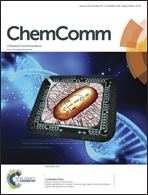A 3-D diamondoid MOF catalyst based on in situ generated [Cu(L)2] N-heterocyclic carbene (NHC) linkers: hydroboration of CO2†
Abstract
A new MOF, [Zn4O{Cu(L)2}2] (1), with a 4-fold interpenetrated 3D diamondoid structure was synthesised from in situ generated [Cu(L)2] NHC linkers. MOF 1 possesses tetrahedral Zn4O nodes, which are unusually coordinated by four pairs of carboxylates from four [Cu(L)2] linkers, and 14 Å 1-D pore channels lined with [Cu(L)2] moieties that catalyse the hydroboration of CO2.
![Graphical abstract: A 3-D diamondoid MOF catalyst based on in situ generated [Cu(L)2] N-heterocyclic carbene (NHC) linkers: hydroboration of CO2](/en/Image/Get?imageInfo.ImageType=GA&imageInfo.ImageIdentifier.ManuscriptID=C4CC04761C&imageInfo.ImageIdentifier.Year=2014)

 Please wait while we load your content...
Please wait while we load your content...